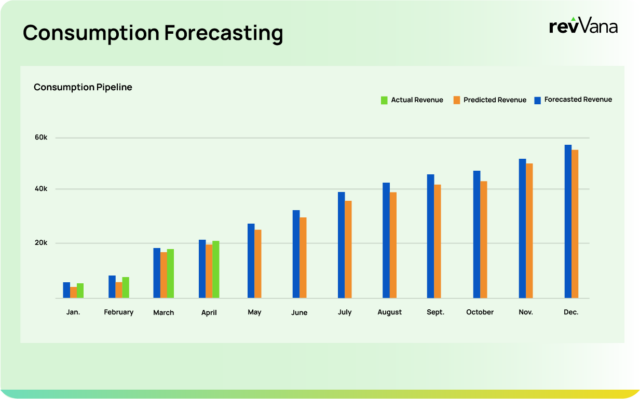Usage-based billing is quickly becoming the dominant revenue model for companies. From cloud infrastructure to SaaS, media, and AI platforms, companies are increasingly adopting pricing strategies that tie revenue directly to customer usage.
In this guide, we’ll explore what usage-based billing is, why it’s gaining traction, the operational challenges it introduces, and why forecasting is such a challenge with this model.
Usage-Based Billing
Usage-based billing (also known as consumption-based billing) is a pricing model where customers pay based on how much of a product or service they use. Unlike subscription models that charge a flat recurring fee, usage-based pricing flexes with consumption. The more a customer uses, the more they pay. If they use less, they pay less.
Common examples include:
- Cloud computing platforms charging per compute hour or data stored
- APIs billed per transaction or request
- AI platforms charging based on token or model usage
- SaaS products offering metered access to features or actions
- Media services billing based on impressions, views, or bandwidth consumed
Usage-based billing aligns revenue with value. Customers only pay for what they use. Businesses grow alongside engagement. It’s a pricing model built for transparency, scalability, and modern buying behavior.
Why Usage-Based Billing Is on the Rise
Several things are accelerating the shift toward usage-based billing:
1. Customer Expectations
Buyers expect flexibility. They want to start small, try products without long-term contracts, and pay proportionally as they scale. Usage-based billing supports this expectation without friction.
2. Product-Led Growth Models
UBB enables companies to land and expand. Customers can begin with low-volume usage, then scale over time without renegotiating pricing. This approach supports high-velocity go-to-market motions.
3. Alignment of Cost and Value
Because pricing reflects usage, customers feel confident they’re paying for actual outcomes. For vendors, this creates a strong correlation between product engagement and revenue.
4. Revenue Expansion Opportunities
Unlike seat-based pricing, usage has no artificial ceiling. As customers grow or embed your product more deeply into their workflows, revenue increases organically.
These benefits have made usage-based billing a powerful strategy for SaaS and digital-first companies looking to drive sustainable growth.
Common Usage-Based Pricing Models
There is no one-size-fits-all approach. Companies typically adopt one or more of the following models:
- Pay-per-use: Customers are charged a flat rate per unit of consumption (e.g., per API call, GB stored).
- Tiered pricing: Pricing increases in defined bands as usage thresholds are reached.
- Volume pricing: The more a customer uses, the lower the unit price becomes.
- Hybrid models: A base subscription fee combined with variable usage-based charges.
- Commitment-based models: Customers commit to a baseline level of spend or usage, with overages billed separately.
Choosing the right model requires a deep understanding of customer behavior, cost structures, and product value metrics.
Challenges of Usage-Based Billing
While the benefits are significant, usage-based billing introduces new challenges across every layer of the business. Unlike traditional models, UBB touches a wider set of systems and stakeholders.
1. Operational Complexity
To implement usage-based billing, companies must build or integrate systems for:
- Metering: Tracking real-time usage per customer
- Rating: Applying pricing logic to that usage
- Invoicing: Turning usage into accurate, auditable bills
- Revenue recognition: Aligning billing data with financial reporting standards
- Customer transparency: Offering detailed usage statements and billing previews
Each of these components must work together, and when a company introduces new pricing models or products, the entire billing stack may need to adjust.
2. Stakeholder Misalignment
Billing is a shared responsibility across engineering, product, finance, sales, marketing, and analytics. Each group has different needs:
- Sales wants pricing flexibility and fast quote turnaround
- Finance requires auditability and accurate forecasting
- Product needs to experiment with packaging
- Engineering builds the infrastructure and needs it to scale reliably
Misalignment across these teams can stall product launches, slow down revenue, or compromise customer experience.
3. Forecasting and Revenue Visibility
Forecasting becomes much harder in usage-based models. Unlike subscriptions with fixed recurring revenue, usage-based revenue is tied to customer behavior that changes in real time.
Key forecasting challenges include:
- Revenue volatility from inconsistent usage
- Delayed visibility until after billing cycles close
- Custom contracts with varying rate cards and commitments
- Disparate data sources across billing, CRM, and finance systems
As usage changes, so does revenue. But many teams don’t discover this until it’s too late. Forecasting tools built for subscription models fail to capture this complexity.

The Forecasting Gap
While metering and invoicing typically receive the most attention, forecasting is a large risk in usage-based billing.
Finance and RevOps teams are often left building manual models in spreadsheets, disconnected from CRM, billing platforms, or actual usage trends. These models quickly become stale, especially as customer behavior shifts.
Without accurate, dynamic forecasting:
- Sales and marketing cannot align goals with reality
- Finance cannot set confident targets or plan for cash flow
- Boards and investors receive outdated guidance
For usage-based billing to be successful at scale, forecasting infrastructure must evolve alongside billing operations.
Forecasting Usage-Based Revenue
Modern SaaS companies need forecasting systems that operate at the speed of product adoption and customer usage. These systems must:
- Integrate with Salesforce and CRM workflows
- Ingest live usage data from billing and metering tools
- Forecast revenue at the customer, SKU, and region level
- Adjust automatically as real usage replaces projected assumptions
- Enable collaboration between finance, sales, and operations
revVana delivers this capability by embedding forecasting inside Salesforce, making real-time, usage-aware revenue models accessible to every stakeholder. Rather than reactively updating spreadsheets, teams can proactively understand how changes in consumption impact top-line revenue.
Usage-based billing is not just a pricing decision. It redesigns how companies acquire, expand, and retain customers. It increases flexibility but also grows complexity.
Success with usage-based billing requires more than flexible pricing. It demands operational alignment, real-time visibility, and forecasting accuracy.
As more SaaS and digital companies adopt usage-based models, those that invest in scalable forecasting will be positioned to plan, grow, and lead.






